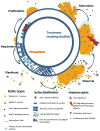Prevention and treatment of Staphylococcus aureus biofilms
- PMID: 26646248
- PMCID: PMC5142822
- DOI: 10.1586/14787210.2015.1100533
Prevention and treatment of Staphylococcus aureus biofilms
Abstract
S. aureus colonizes both artificial and tissue surfaces in humans causing chronic persistent infections that are difficult to cure. It is a notorious pathogen due to its antibiotic recalcitrance and phenotypic adaptability, both of which are facilitated by its ability to develop biofilms. S. aureus biofilms challenge conventional anti-infective approaches, most notably antibiotic therapy. Therefore there is an unmet need to develop and include parallel approaches that target S. aureus biofilm infections. This review discusses two broad anti-infective strategies: (1) preventative approaches (anti-biofilm surface coatings, the inclusion of biofilm-specific vaccine antigens); and (2) approaches aimed at eradicating established S. aureus biofilms, particularly those associated with implant infections. Advances in understanding the distinct nature of S. aureus biofilm development and pathogenesis have led to growing optimism in S. aureus biofilm targeted anti-infective strategies. Further research is needed however, to see the successful administration and validation of these approaches to the diverse types of infections caused by S. aureus biofilms from multiple clinical strains.
Keywords: Staphylococcus aureus; anti-infective strategies; antibiotic tolerance; biofilm infections; device related infections; persistence; prosthetic implants.
Figures

Similar articles
-
Tolerant Small-colony Variants Form Prior to Resistance Within a Staphylococcus aureus Biofilm Based on Antibiotic Selective Pressure.Clin Orthop Relat Res. 2021 Jul 1;479(7):1471-1481. doi: 10.1097/CORR.0000000000001740. Clin Orthop Relat Res. 2021. PMID: 33835090 Free PMC article.
-
Small Molecules Produced by Commensal Staphylococcus epidermidis Disrupt Formation of Biofilms by Staphylococcus aureus.Appl Environ Microbiol. 2020 Feb 18;86(5):e02539-19. doi: 10.1128/AEM.02539-19. Print 2020 Feb 18. Appl Environ Microbiol. 2020. PMID: 31862721 Free PMC article.
-
Antibiotic Susceptibility of Staphylococcus aureus Plankton and Biofilm Forms Isolated in Implant-Associated Infection.Bull Exp Biol Med. 2021 Nov;172(1):46-48. doi: 10.1007/s10517-021-05328-8. Epub 2021 Nov 18. Bull Exp Biol Med. 2021. PMID: 34792719
-
An update on recent developments in the prevention and treatment of Staphylococcus aureus biofilms.Int J Med Microbiol. 2019 Jan;309(1):1-12. doi: 10.1016/j.ijmm.2018.11.002. Epub 2018 Nov 27. Int J Med Microbiol. 2019. PMID: 30503373 Review.
-
Current and future approaches to the prevention and treatment of staphylococcal medical device-related infections.Curr Pharm Des. 2015;21(1):100-13. doi: 10.2174/1381612820666140905123900. Curr Pharm Des. 2015. PMID: 25189861 Review.
Cited by
-
Antimicrobial activity of α/β hybrid peptides incorporating tBu-β3,3Ac6c against methicillin-resistant Staphylococcus aureus.J Antibiot (Tokyo). 2024 Dec;77(12):794-801. doi: 10.1038/s41429-024-00773-9. Epub 2024 Oct 29. J Antibiot (Tokyo). 2024. PMID: 39472525
-
Liposomes as a Nanoplatform to Improve the Delivery of Antibiotics into Staphylococcus aureus Biofilms.Pharmaceutics. 2021 Mar 2;13(3):321. doi: 10.3390/pharmaceutics13030321. Pharmaceutics. 2021. PMID: 33801281 Free PMC article.
-
Inhibition of Mixed Biofilms of Candida albicans and Methicillin-Resistant Staphylococcus aureus by Positively Charged Silver Nanoparticles and Functionalized Silicone Elastomers.Pathogens. 2020 Sep 25;9(10):784. doi: 10.3390/pathogens9100784. Pathogens. 2020. PMID: 32992727 Free PMC article.
-
Development of systemic immune dysregulation in a rat trauma model of biomaterial-associated infection.Biomaterials. 2021 Jan;264:120405. doi: 10.1016/j.biomaterials.2020.120405. Epub 2020 Sep 25. Biomaterials. 2021. PMID: 33069135 Free PMC article.
-
Carvacrol inhibits bacterial polysaccharide intracellular adhesin synthesis and biofilm formation of mucoid Staphylococcus aureus: an in vitro and in vivo study.RSC Adv. 2023 Oct 5;13(41):28743-28752. doi: 10.1039/d3ra02711b. eCollection 2023 Sep 26. RSC Adv. 2023. PMID: 37807974 Free PMC article.
References
-
- Sollid JUE, Furberg AS, Hanssen AM, et al. Staphylococcus aureus: determinants of human carriage. Infect Genet Evol. 2014;21:531–541. - PubMed
-
- Hawkins G, Stewart S, Blatchford O, et al. Should healthcare workers be screened routinely for meticillin-resistant Staphylococcus aureus? A review of the evidence. J Hosp Infect. 2011;77(4):285–289. - PubMed
-
- Haill C, Allwood A, Kearns AM, et al. Staff-to-patient transmission of meticillin-resistant Staphylococcus aureus: do bacterial factors play a role? J Hosp Infect. 2011;79(3):275–277. - PubMed
Publication types
MeSH terms
Substances
Grants and funding
LinkOut - more resources
Full Text Sources
Other Literature Sources
Medical
